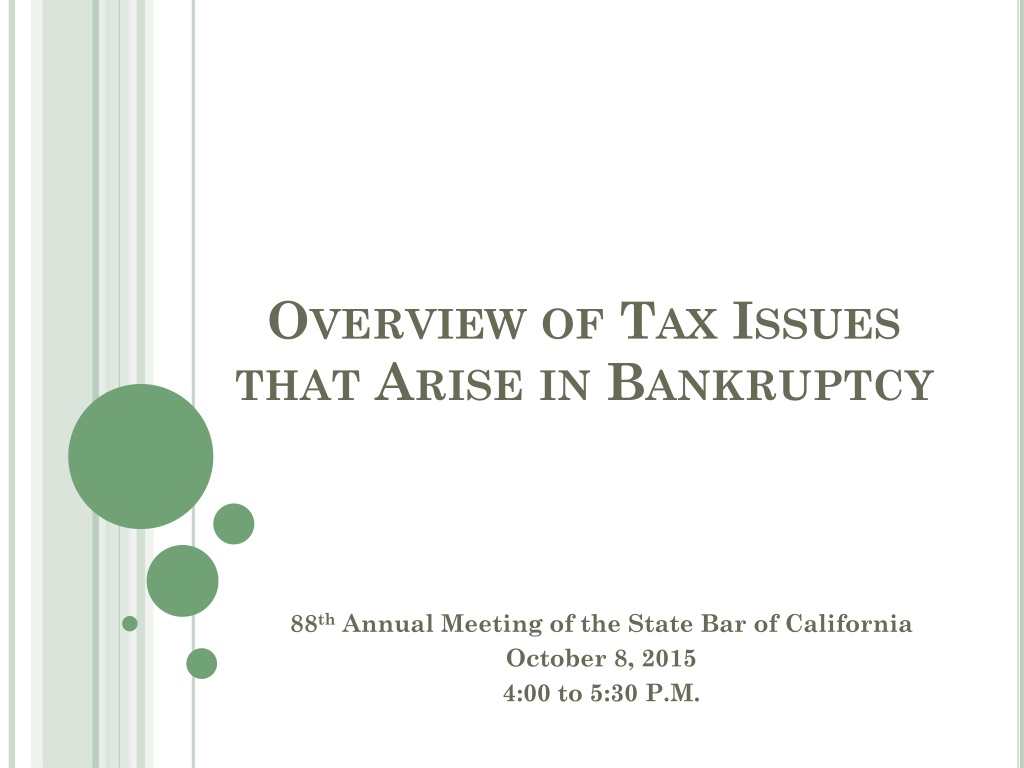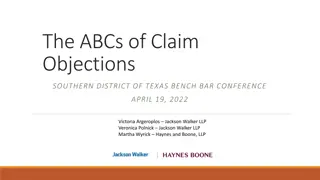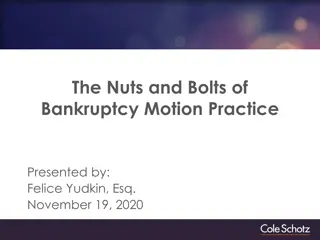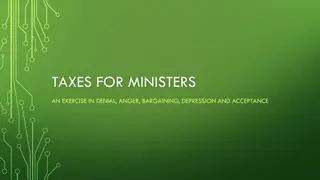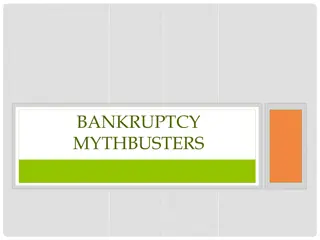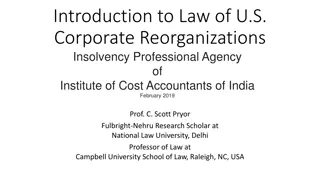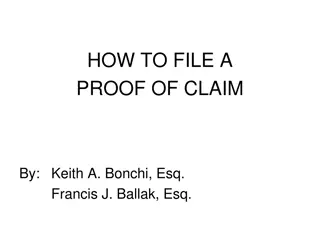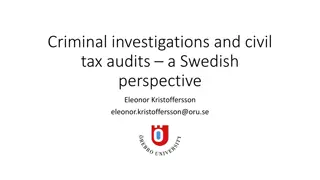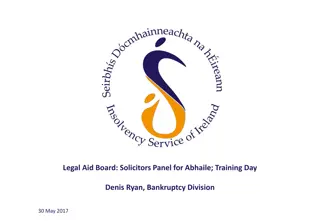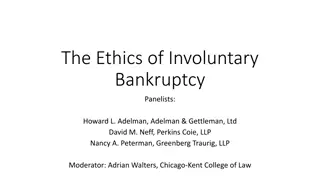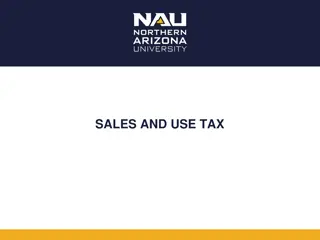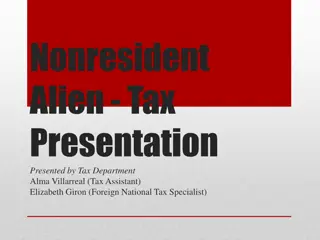Tax Issues in Bankruptcy Proceedings
Explore the key tax issues that arise in bankruptcy, including discharge, treatment of tax claims, nondischargeable tax debt, and priority taxes under 11 U.S.C. 507. Learn about the impact on individual and corporate debtors, as well as the types of taxes that may be discharged or deemed nondischargeable.
Download Presentation

Please find below an Image/Link to download the presentation.
The content on the website is provided AS IS for your information and personal use only. It may not be sold, licensed, or shared on other websites without obtaining consent from the author.If you encounter any issues during the download, it is possible that the publisher has removed the file from their server.
You are allowed to download the files provided on this website for personal or commercial use, subject to the condition that they are used lawfully. All files are the property of their respective owners.
The content on the website is provided AS IS for your information and personal use only. It may not be sold, licensed, or shared on other websites without obtaining consent from the author.
E N D
Presentation Transcript
OVERVIEW OF TAX ISSUES THAT ARISE IN BANKRUPTCY 88thAnnual Meeting of the State Bar of California October 8, 2015 4:00 to 5:30 P.M.
DISCHARGE IN BANKRUPTCY A discharge received by an individual debtor in a chapter 7, 11, or 13 will generally discharge all debts, unless an express exception applies. A corporate debtor does not receive a discharge in a chapter 7 case. A corporate debtor receives a discharge in a chapter 11 case, except in a liquidating case.
TREATMENT OF TAX CLAIMS IN BANKRUPTCY Whether or not a tax claim may be discharged will depend on: The type of tax (e.g., income, property, trust fund, employment, etc.) The date the tax was assessed The date the tax return was due Whether it is a tax or a penalty
NONDISCHARGEABLE TAX DEBT Taxes that receive priority status under 11 U.S.C. 507(a)(8) are nondischargeable in Chapter 7 and 11. Taxes that are nondischargeable under 11 U.S.C. 523(a)(1) in Chapter 7 and 11 must be paid by the debtor/taxpayer.
PRIORITY TAXES UNDER 11 U.S.C. 507(A)(8) 507(a)(8)(A) gives eighth priority to claims for taxes measured by income or gross receipts for a taxable year ending on or before the petition date if: The due date of the return (including extensions) is after three years before the petition date; The taxes were assessed within 240 days before the petition date (with extensions for time an OIC was pending or in effect, or collection was stayed); or the taxes are assessable, but not yet assessed as of the petition date (excluding 523(a)(1)(B) or 523(a)(1)(C) taxes). Claims for federal and California income taxes that meet one of these tests are entitled to eighth priority and not dischargeable.
PRIORITY TAXES UNDER 11 U.S.C. 507(A)(8), CONT. 507(a)(8)(E) gives eighth priority to claims for excise taxes on: a pre-petition transaction if the due date of the return (including extensions) is after three years before the petition date; or if a return is not required, a transaction occurring within the three years prior to the petition date. Are claims for prepetition California sales or use taxes covered by 507(a)(8)(A) or 507(a)(8)(E)? The sales tax is a tax on gross receipts. RTC 6051. The use tax is an excise tax on the sales price. RTC 6201. The definitions of gross receipts and sales price are nearly identical. RTC 6012, 6011.
PRIORITY TAXES UNDER 11 U.S.C. 507(A)(8), CONT. In Raiman v. Board of Equalization, 172 B.R. 933 (9th Cir. BAP 1994), the court determined that the sales tax was a tax on gross receipts under 507(a)(8)(A), but left open the possibility that it was also an excise tax under 507(a)(8)(E). The result would have been the same under subparagraph (E). Given the similarity of the use tax to the sales tax, it is worth considering whether the discussion in Raiman also applies to use tax. Does it matter? Probably not. Subparagraphs (A) and (E) both give eighth priority to taxes for which returns were due after three years before the petition date.
PRIORITY TAXES UNDER 11 U.S.C. 507(A)(8), CONT. Other Priority Tax Claims (B): pre-petition property tax claims last payable without penalty after one year before the petition date (C): trust fund taxes (OASDI, sales, some excise) (D): pre-petition employment taxes on pre-petition priority wages/commissions paid under 507(a)(4)
CLASSIFICATION AS EIGHTH PRIORITY NONDISCHARGEABLE CLAIM The two most frequent tests to consider age of tax liability for taxes measured by income and gross receipts are: (1) The Three-Year Rule (2) The 240-Day Rule
THE THREE YEAR RULE Section 507(a)(8)(A)(i) prepetition income and gross receipts taxes (including CA sales (and use) taxes) return is due (including extensions) after three years before petition date Suspended under the hanging paragraph at the end of 507(a)(8)
THE THREE YEAR RULE, CONT. Income Tax Example: 2010 Return is due 4/15/11. Extension received to 10/15/11. Return filed 7/1/11. Petition filed 8/1/2014 3-Year Lookback: 8/1/2011 - 8/1/2014 10/15/11 Extended Due Date falls within the 3-year lookback Therefore it is a priority tax.
THE THREE YEAR RULE, CONT. CA Sales Tax Example: 1st Quarter 2011 Return is due 4/30/2011 Petition filed 8/1/2014 3 Year Lookback: 8/1/2011 - 8/1/2014 4/30/2011 Due Date falls outside of the 3 year lookback Therefore, it is not a priority tax
INCOME TAX RETURN DUE DATES Federal: 15thDay of April for calendar year taxpayers; 15thDay of fourth month following the close of the year for fiscal year taxpayers. 26 USC 6072(a). California: 15thday of following April for calendar-year taxpayers; 15th day of fourth month following close of year for fiscal-year taxpayers. RTC 18566.
SALES AND USE TAX RETURN DUE DATES Quarterly filers: due by the last day of the month following each quarterly period. RTC 6451. Other types of filers (monthly, yearly, or fiscal yearly): due by the last day of the month following each designated period. RTC 6455. Due dates are specified at: www.boe.ca.gov/sutax/fill_dates.htm May elect to report and remit use tax on CA income tax return. RTC 6452.1.
EXTENSIONS Federal Income Tax: Automatic 6-month extensions for Individuals. 26 USC 6081(a); Treas. Reg. 1.6081- 4(a). CA Income Taxes: Automatic extensions until October 15thif filed after April 15thand on or before October 15th. RTC 18567; 18 CCR 18567. CA Sales & Use Taxes: 30-day extension may be granted for good cause. RTC 6459.
THE 240-DAY RULE Section 507(a)(8)(A)(ii) Income taxes, and CA sales (and use) taxes assessed within 240 days prior to the filing of the petition will be classified as eighth priority, nondischargeable tax liabilities in chapter 7 and 11. Caveat: An erroneous calculation of assessment period by the IRS will not excuse debtor who files petition before the 240-day period has expired. In re Howell, 120 B.R. 137 (B.A.P. 9thCir. 1990) (IRS negligently provided taxpayer with wrong assessment date).
THE 240-DAY RULE, CONT. CA Income, Sales and Use Taxes: Liabilities for proposed assessments (determinations) are deemed assessed when the determination is final. See In re King, 961 F. 2d 1423 (9th Cir. 1992) (California income tax is not assessed when notice of proposed assessment was mailed, but rather 60-days later when the period to file a protest expired). Sales and use tax determinations become final 30 days after a notice of determination is issued absent the filing of a petition for redetermination. RTC 6561.
TOLLING OF 240-DAY RULE 240-day period is suspended during any time there is a stay of collection from a prior bankruptcy (plus 90 days) 507(a)(8)(A)(ii)(II) 240-day period is suspended during period (plus 30 days) in which offer in compromise is pending or in effect 11 U.S.C. 507(a)(8)(A)(ii)(I); See In re Klein, 189 B.R. 505 (C.D. Cal. 1995). Also, suspended under the hanging paragraph at the end of 507(a)(8)
SOL ON ASSESSMENT? Federal: three years beginning with the date the return is filed during which it may audit a taxpayer s return and assess a deficiency. 26 U.S.C. 6501(a) six years if there is a 25% or greater omission from gross income on the examined return. 26 U.S.C. 6501(e)(1)(A). no statute of limitations for the assessment of a tax liability relating to a tax return that is fraudulent. 26 U.S.C. 6501(c)(1). Statute of limitations is suspended by issuance of notice of deficiency 26 USC 6503(a)(1) See Revenue Ruling 2003-80 for examples
SOL ON ASSESSMENT? CONT. CA Income Tax: four years beginning with the date the return is filed during which it may mail a notice of proposed deficiency assessment. RTC 19057. six years from the date the return is filed if there is a 25% or greater omission from gross income on the return. RTC 19058. no statute of limitations if the return is false or fraudulent, or if a return is never filed. RTC 19057. in the case of federal adjustments that are timely reported to the FTB, two years from the date the amended return is filed with the FTB, or the date the notice is filed by the taxpayer or the IRS reporting a federal change. RTC 19059.
SOL ON ASSESSMENT? CONT. CA Sales and Use Tax: Return Filed: Except in the case of fraud or intent to evade tax, notice of a deficiency determination must be mailed within 3 years after the due date of the return (i.e., the last day of the calendar month following the quarterly or annual filing period), or within three years after the return is filed, whichever is later. RTC 6487. No Return Filed: Except in the case of fraud or intent to evade tax, notice of the deficiency determination must be issued within 8 years after the last day of the calendar month following the quarterly or annual period for which the amount is proposed to be determined. RTC 6487. Personal liability of responsible persons, corporate officers, partners, etc. See RTC 6829.
EXCEPTIONS TO DISCHARGE UNDER 11 U.S.C. 523 Taxes attributable to delinquent tax returns. 523(a)(1)(B). An individual does not receive a discharge under chapter 7, 11, or 13 for any tax if a return was required and either: No return was filed, or The return was filed late and after two years before the petition date.
EXCEPTIONS TO DISCHARGE UNDER 11 U.S.C. 523, CONT. Taxes with respect to which the debtor made a fraudulent tax return or willfully attempted in any manner to evade or defeat such tax. 523(a)(1)(C). Fraud. Taxing authority has burden of proving fraud by a preponderance of the evidence. Grogan v. Garner, 498 U.S. 279, 287 (1991). The preponderance of the evidence standard applies to all creditors seeking an exception to discharge under 523. Id.
EXCEPTIONS TO DISCHARGE UNDER 11 U.S.C. 523, CONT. Fraud (cont.) To prove that the debtor made a fraudulent return, the government must prove a civil fraud violation under [26 U.S.C. 6663]. McKay v. U.S., 957 F.2d 689, 691 (9thCir. 1992); In re Carey, 326 B.R. 816, 821 (Bankr. E.D.Cal. 2005). To establish liability [under section 6663], the Government must establish: (1) a knowing falsehood; (2) an intent to evade taxes; and (3) an underpayment of tax. Considine v. U.S., 683 F.2d 1285, 1286 (9thCir. 1982).
EXCEPTIONS TO DISCHARGE UNDER 11 U.S.C. 523, CONT. Willfully attempted . . . . In the Ninth Circuit, the phrase willfully attempted in any manner to evade or defeat such tax requires a showing of specific intent to evade the tax. Hawkins v. Franchise Tax Board et al., 769 F.3d 662, 669 (9th Cir. 2014) (emphasis added). In that case, the court determined that unnecessary expenditures combined with nonpayment of known outstanding tax liabilities does not constitute a willful attempt to evade or defeat absent evidence of specific intent to do so.
EXCEPTIONS TO DISCHARGE UNDER 11 U.S.C. 523, CONT. The willfully attempt language has generated a lot of litigation: Failure to timely file tax returns and pay taxes is evidence of evasive conduct. In re Mitchell, 633 F.3d 1319, 1327 (11th Cir. 2011); In re Fegeley, 118 F.3d 979, 984 (3rd Cir. 1997); In re Toti, 24 F.3d 806, 809 (6th Cir.), cert. denied, 513 U.S. 987 (1994). A single attempt to avoid collection may be grounds for nondischargeability. In re Gillis, 251 B.R. 920, 923 (Bankr. S.D.Ga. 2000). Fraudulent bankruptcy schedules may be grounds for nondischargeability. U.S. v. Merrill, 336 B.R. 804, 808 (D.Or. 2005) ( The scope of this exception encompasses the conduct of defendant, who filed a fraudulent bankruptcy petition and now relies in part upon that filing as a basis for attempting to defeat his tax liability. ).
DOES TAX RETURN QUALIFY AS RETURN ? Beard v. Commissioner, 82 T.C. 766 (1984), aff d, 793 F2d 139 (6th Cir. 1986) in order for a document to qualify as a return, it must, (1) purport to be a return, (2) be executed under penalty of perjury, (3) contain sufficient data to allow calculation of tax, and (4) represent an honest and reasonable attempt to satisfy the requirements of the tax law.
DOES TAX RETURN QUALIFY AS RETURN ? CONT. Attempt to file a return after assessment (via Substitute for Return) In re Hindenlang, 164 F.3d 1029, 1034 (6th Cir. 1999) the Form 1040 serves no tax purpose and therefore does not constitute a return under the Internal Revenue Code nor a return for purposes of dischargeability under section 523(a)(1)(B)(i). In re Hatton, 220 F.3d 1057 (9th Cir. 2000) Recognized Beard test TP s agreement regarding liability and signing installment agreement does not meet return test and taxes are nondischargeable under 523(a)(1)(B)(i).
CALIFORNIA LAW AMENDED OR CORRECTED TAX RETURN California requires taxpayers report changes or corrections made by the IRS that increase the amount of tax owed to the FTB within six months of the final federal determination. RTC 18622. Failure to report changes or corrections will render nondischargeable the tax liability due to such changes or corrections. 11 USC 523(a)(1)(B)(i); In re Ciotti, 638 F.3d 276 (4thCir. 2011); In re Shorton, 375 B.R. 26 (Bankr.D. Mass. 2007).
DISCHARGEABILITY OF INTEREST AND PENALTIES Interest Discharged only when the related tax or penalty is discharged (In re Artisan Woodworkers, 204 F.3d 888, 891 (9thCir. 2000); In re Burns, 887 F.2d 1541, 1543 (11thCir. 1989); In re Teeslink, 165 B.R. 708, 717-718 (Bankr. S.D. Ga. 1994)). Penalties (11 U.S.C. 523(a)(7)) A fine, penalty, or forfeiture payable to a governmental unit for its benefit, which does not constitute compensation for actual pecuniary loss, is nondischargeable if (a) related to a tax of the kind specified in 523(a)(1) and (b) imposed with respect to a transaction or event that occurred on or after three years before the petition date. McKay v. US, 957 F.2d 689, 693-94 (9thCir. 1992); In re Burns, 887 F.2d 1541, 1544 (11thCir. 1989).
CANCELLATION OF INDEBTEDNESS INCOME General principles: Under IRC section 61(a)(12), a debtor will realize income upon the discharge of debt for less than its face value since the debtor s net worth has increased. A negotiated discharge may be achieved by the issuance of (i) stock in exchange for the debt; (ii) property in exchange for the debt; or (iii) new debt in exchange for the old debt. By contrast, creditors may unilaterally discharge obligations which may result in unanticipated COD income to the debtors.
CANCELLATION OF INDEBTEDNESS INCOME, CONT. In order to qualify as COD income, the debt must be liquidated and not contested at the time of the discharge. The discharge of a debt for services will not result in COD income. ILM 200130038 (May 31, 2001 (a discharge for services rendered is compensation income reportable under section 6041 and not COD reportable under 6050P)).
. CANCELLATION OF INDEBTEDNESS INCOME, CONT. Example #1: Bob purchases a computer from Seller and signs a promissory note in the sum of $1,000 in exchange. Bob subsequently defaults on his obligation and Seller decides to bring an action for breach of contract, to which Bob counterclaims. The parties decide to settle their case for payment of $500 by Bob and a discharge and full release from Seller. Will Bob realize COD income? Answer: No, the contested liability doctrine should apply. (See Preslar v. Comm r., 167 F.3d 1323 (10th Cir. 1999) (contested liability doctrine applies only if the original debt is unliquidated); CCA 200402004 (Nov. 26, 2003) (discharge of a restitution obligation is not a COD income event).)This may also qualify as a purchase price adjustment under section 108(e)(5).
CANCELLATION OF INDEBTEDNESS INCOME, CONT. Example #2: Shelly Shareholder personally guarantees the lease agreement for her S- corporation. The corporation subsequently defaults and the lessor demands payment on the guarantee. However, given the downturn in the economy and Shelly s financial hardship, the lessor decides to cancel the guarantee obligation. What are the Federal income tax consequences? Answer: The release from a guarantee should not create COD income (Treas. Reg. 1.6050P-1(d)(7) (for purposes of reporting, a guarantor is not a debtor); see also Harris v. United States, 902 F.2d 439, 445 (5th Cir. 1990) (stock basis not increased because unperformed guarantees do not constitute an economic outlay by the guarantors).) However, in other contexts, a release from a guarantee may constitute a significant modification of the debt instrument. (Treas. Reg. 1.1001-3(e)(4)(iv).)
EXCEPTION TO CODI BANKRUPTCY The Code provides an exclusion from recognition of COD income for a debtor in a title 11 proceeding and for debtors outside of bankruptcy who are considered insolvent, but only to the extent of insolvency. The amount of debt discharge in excess of insolvency is recognized as taxable COD income. In addition to the required bankruptcy and insolvency exclusions, the Code contains certain elective exclusions for Qualified Principal Residence Indebtedness and Qualified Real Property Business Indebtedness, which taxpayers may use to exclude COD income. Title 11 Proceeding. In order to qualify for the bankruptcy exception, the debtor must receive a discharge in a title 11 case. (I.R.C. 108(a)(1)(A).) A title 11 case means a case under title 11 of the United States Code (relating to bankruptcy), but only if the taxpayer is under the jurisdiction of the court in such case and the discharge of indebtedness is granted by the court or is pursuant to a plan approved by the court. (I.R.C. 108(d)(2).) A debtor in a title 11 proceeding will be entitled to exclude COD income regardless of its insolvency.
EXCEPTION TO CODI BANKRUPTCY Example #1: A, B, and C decide to form a California LLC, which is taxed as a partnership. The LLC borrows $12 million to finance operating expenses. Unfortunately, the business fell on hard economic times and in 2011, filed for bankruptcy protection and received a discharge of the $12 million obligation. To what extent will each of the three members of the LLC be entitled to relief from their $4 million share of the COD income under section 108? Answer: No relief for individual members under the bankruptcy exclusion. Section 108(d)(6) states that the provisions of section 108(a), (b), (c) and (g) are applied at the partner level; not the partnership. Since only the LLC filed for bankruptcy relief, the individual partners will not be entitled to relief under the bankruptcy exclusion. However, the partners may be entitled to exclude COD income to the extent of their insolvency.
EXCEPTION TO CODI BANKRUPTCY Example #2: Assume the same factual scenario as Example #1 (above) except that instead of an LLC, the entity was an S-corporation. Are the tax consequences of the $12 million discharge now determined by the corporation s bankruptcy? Answer: Yes. (I.R.C. 108(d)(7).)
EXCEPTION TO CODI INSOLVENCY Determining Insolvency. The Code defines insolvency as the excess of liabilities over the fair market value of assets. I.R.C. 108(d)(3). The fair market value of assets is determined on a going concern basis. Liabilities, including contingent obligations are taken into account at face value and are not discounted for contingencies or the time value of the obligation. The insolvency computation is determined immediately before the debt discharge.
EXCEPTION TO CODI INSOLVENCY Defining assests and liabilities. Neither assets nor liabilities are currently defined by the Code or the Regulations. The term assets has been interpreted broadly to include tangible and intangible assets. In addition, the Tax Court and IRS have taken the position that assets exempt from creditor s claims under state law are included in the definition of assets for purposes of the insolvency computation. (Carlson v. Commissioner, 116 T.C. 87 (2001); but see Naimi, The Definition of Assets Under the Insolvency Exclusion (forthcoming) (seeking proposed guidance from Treasury defining assets to exclude those assets exempt under state or federal law.).
EXCEPTION TO CODI INSOLVENCY By contrast, the term liabilities has been interpreted narrowly to include contingent liabilities only if the taxpayer can produce evidence that the taxpayer will more likely than not be called upon to pay the obligation. (Merkel v. Commissioner, 192 F.3d 844 (9th Cir. 1999); but see Naimi, Proposed Guidance Under Section 108(d)(3), Tax Analyst 2011 TNT 111-36 (seeking proposed guidance from Treasury defining liabilities to include contingent liabilities at their discounted value.).
EXCEPTION TO CODI INSOLVENCY Timing of Insolvency Determination. Section 108(d)(3) provides that the amount of COD excluded from gross income is determined on the basis of the assets and liabilities of the debtor immediately before the discharge. Unless there is an actual negotiation for payment of the debt involved between the debtor and creditor, the timing of the discharge may become questionable and have severe economic consequences if the taxpayer is no longer insolvent when the creditor issues Form 1099-C.
EXCEPTION TO CODI INSOLVENCY E.g., in Cozzi v. Comm r, 88 T.C. 35 (1987), no identifiable event occurred to make it clear debt would never be repaid. The Tax Court explained that (i) a debt is discharged the moment it becomes clear that the debt will never be repaid, (ii) determining that moment requires a practical assessment of the likelihood of repayment (collection), and (iii) an identifiable event that fixes the loss (from the creditor s perspective). See also Treas. Reg. 1.6050P-1(b) (rebuttable presumption that an identifiable event has occurred if the creditor has received no payments within 36 months).
EXCLUSION OF CODI ATTRIBUTE REDUCTION Attribute Reduction. Taxpayers who are able to benefit from the insolvency or bankruptcy exclusion of COD income must reduce their tax attributes in the following order: 1) Net Operating Losses (NOLs). NOLs from the taxable year of discharge are reduced first, on a dollar for dollar basis. Once these NOLs are exhausted then NOL carryovers are reduced in the order in which they arose. (I.R.C. 108(b)(2)(A), (b)(3)(A), (b)(4)(B).) NOLs are available to offset operating income in excess of insolvency, in the taxable year of the discharge since attribute reduction does not take place until after the determination of tax for the taxable year of the discharge. (I.R.C. 108(b)(4)A).) 2) General Business Credit. Any carryover of business credits to or from the taxable year of a discharge are reduced 33-1/3 cents for each dollar. (I.R.C. 108(b)(2)(B), (b)(3)(B), (b)(4)(C).)
EXCLUSION OF CODI ATTRIBUTE REDUCTION 3) Minimum Tax Credit. The amount of the minimum tax credit as of the beginning of the taxable year immediately following the taxable year of the discharge, are reduced, 33-1/3 cents on the dollar. (I.R.C. 108(b)(2)(C), (b)(3)(B).) 4) Capital Loss Carryovers. Any net capital loss for the taxable year of the discharge, and then any carryovers are reduced dollar for dollar, first from the year of the discharge and then in the order in which they arose. (I.R.C. 108(b)(2)(D), (b)(3)(A), (b)(4)(B).) 5) Asset Basis Reduction. The basis of any property (depreciable and nondepreciable) is reduced dollar for dollar. (I.R.C. 108(b)(2)(E), (b)(3)(A), (b)(4)(A).) 6) Passive Activity Loss and Credit Carryovers. Any passive activity losses or credit carryovers of the taxpayer, are reduced 33-1/3 cents on the dollar in the order in which they arose, from the taxable year of the discharge. (I.R.C. 108(b)(2)(F), (b)(3)(B).)
EXCLUSION OF CODI ATTRIBUTE REDUCTION 7) Foreign Tax Credit Carryovers. Foreign tax credit carryovers to or from the taxable year of the discharge, are reduced 33-1/3 cents on the dollar, in the order in which they arose. (I.R.C. 108(b)(2)(E), (b)(3)(A), (b)(4)(A).) 8) Election to Reduce Basis of Depreciable Property. Taxpayers may elect to reduce the basis of depreciable property instead of the foregoing attribute reductions. (I.R.C. 108(b)(5).) Depending on the taxpayer s attributes and financial circumstances, a taxpayer may elect under section 108(b)(5) to treat inventory as depreciable property. (I.R.C. 1017(b)(3)(E).) The election under section 108(b)(5) must be made on the tax return for the year of the discharge. (I.R.C. 108(d)(9).)
EXCEPTION TO CODI QUALIFIED PRINCIPAL RESIDENCE DEBT Qualified Principal Residence Debt. Qualified principal residence indebtedness ( QPRI ) secured by the taxpayer s principal residence that is discharged before January 1, 2013 due to a decline in the value of the residence or the financial condition of the taxpayer will be excluded from the taxpayer s income. (I.R.C. 108(a)(1)(E), (h)(3).) The term QPRI means acquisition indebtedness up to $2 million incurred to acquire, construct, or substantially improve the taxpayer s principal residence, including debt incurred to refinance outstanding QPRI. (I.R.C. 108(h)(2).) The amount excluded from gross income by reason of the QPRI exclusion will be applied to reduce the basis of the taxpayer s principal residence dollar for dollar, but not below zero. (I.R.C. 108(h)(1).) The QPRI exclusion takes precedence over the insolvency exclusion unless the taxpayer elects otherwise. (I.R.C. 108(a)(2)(C).) NO LONGER AVAILABLE - Expired
EXCEPTION TO CODI QUALIFIED REAL PROPERTY BUSINESSES Qualified Real Property Businesses. Taxpayers (other than C corporations so REITs will not qualify) facing cash flow problems who are otherwise solvent may elect to exclude certain COD income generated when qualified real property business indebtedness ( QRPBI ) is discharged. (I.R.C. 108(a)(1)(D).) QRPBI generally includes debt incurred or assumed before January 1, 1993 in connection with the acquisition or substantial improvement of real property used in a trade or business and secured by the real property. (I.R.C. 108(c)(3).) The amount of COD income excluded from gross income is applied to reduce the basis of the taxpayer s depreciable real property. (I.R.C. 108(c)(1)(A) and (B); 1017.) The amount of COD income that may be excluded when QRPBI is discharged is subject to two limitations:
EXCEPTION TO CODI QUALIFIED REAL PROPERTY BUSINESSES Indebtedness in Excess of Value the excluded COD income is limited to the excess of the (i) outstanding principal amount of QRPBI (immediately before the discharge) over (ii) the fair market value of the real property securing the QRPBI immediately before the discharge. (I.R.C. 108(c)(2)(A). Treas. Reg. 1.108-6(a) provides that for purposes of section 108(c)(2)(A), outstanding principal amount means the principal amount of indebtedness together with all additional amounts owed that, immediately before the discharge, are equivalent to principal, in that interest on such amounts would accrue and compound in the future, except that outstanding principal amount shall not include amounts that are subject to section 108(e)(2) and shall be adjusted to account for unamortized premium and discount consistent with section 108(e)(3).) Overall Limitation the amount of excludable COD income shall not exceed the aggregate adjusted basis of depreciable real property held by the taxpayer immediately before the discharge (other than depreciable real property acquired in contemplation of such discharge). (I.R.C. 108(c)(2)(B).)
CODI DETERMINATION ENTITY IMPLICATIONS Implications of COD Income For Various Entity Forms. The determination of whether COD income is recognized and excluded will vary depending upon the type of debtor entity form. S-Corporation. The determination of whether income from discharge of an S-corporation s debt is excluded from gross income is made at the corporate level. The corresponding tax attribute reductions are made at the S-corporation level. (I.R.C. 108(d)(7).) Neither the exclusion nor attribute reduction from COD income pass-through to the shareholders. Partnerships. The determination of whether COD income is recognized in connection with a partnership debt discharge is determined at the partnership level, while the exclusions from COD income recognition and corresponding tax attribute reductions are applied at the partner level. ( I.R.C. 108(d)(6).) Disregarded Entities. All assets, liabilities, and items of income, deduction, and credit of a disregarded entity are treated as assets and liabilities of the owner. (Prop. Reg. 1.108-9, REG-154159-09, Doc 2011-7755, 2011 TNT 71-9. Under the check-the-box Treasury Regulations, most limited liability companies (LLCs) are taxed as partnerships for Federal income tax purposes unless they elect to be taxed as corporations. Prop. Reg. section 1.108-9 clarifies that domestic single-member LLCs that elect not to be classified as a corporation, fall within the category of a disregarded entity and the income will, therefore, pass-through to the owner for Federal income tax purposes. The activities of an entity that is disregarded for tax purposes, is treated (with limited exception) as a sole proprietor, branch or division of the owner.) Therefore, both the exclusion and attribute reduction from the COD income are made at the owner/taxpayer level.
CODI EXCEPTIONS The following COD exceptions apply without the cost of tax attribute reduction: A. from the discharge of a liability to the extent payment of the liability gives rise to a deduction. (I.R.C. 108(e)(2).) Examples of such liabilities include interest, salary and rent. Section 108(e)(2). COD income is not recognized B. considered purchase money, the reduction will be treated as a purchase price adjustment rather than COD. (I.R.C. 108(e)(5).) This exception only applies where the purchaser is neither insolvent nor in a title 11 case. Section 108(e)(5). If the debt which is reduced is
